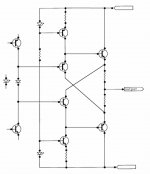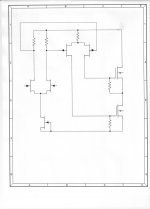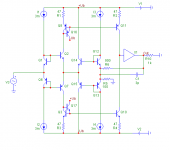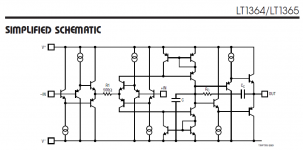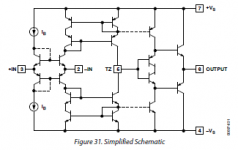He says right in the article that a version of it was first used in the LH0002 buffer, which I assume was a chip.
I have about 20 of them on PCBs. Do they have any ebay value?
I used discrete version of diamond buffer in phaser pedal for keyboard, in 1970'th. It was all discrete, with LDRs around a light bulb, using pnp+npn "concertinas" for APFs. Such a way I kept almost zero level shift.
can you tell us in which ways this is different from an IC packaged circuit? What parameters can be bettered with discrete (besides output current)? Thx RNM
No claims made other than output current, bias, etc. diy'ers feel good about doing it themselves i.e. fun.
The H in LH was for hybrid (IIRC)He says right in the article that a version of it was first used in the LH0002 buffer, which I assume was a chip.
No claims made other than output current, bias, etc. diy'ers feel good about doing it themselves i.e. fun.
Please explain in more detail the rising thd with frequency cause. Thx - RNM
Last edited:
Yes, this is the usual method of bringing the opposing collectors of the input to the rail... Was Walt Jung first or?? But, the variation of bringing them to the output stage, between the emitter resistor and the output device is an improvement. Incremental. But incremental counts?
I believe HP used the diamond buffer pretty early on, according to Rich May, who then did some discrete buffers for a crossover he did at Harman for Greg Timbers. But who knows --- as Scott pointed out in connection with Jensen's input inductor(s), these things often are proprietary within a company for a while, and thus the USPTO doesn't necessarily know about them when they review claims.
Rich also bootstrapped the collectors of the input devices for his circuit, but did so with big caps and resistors to the rail, rather than running them from the output device emitters. This has advantages (smaller Ccb to begin with), but requires some bulky caps.
Both bootstrapping approaches help reduce the effects of the voltage-variable collector-base capacitances, as well as Early effects on beta and Vbe. The capacitance variation is a distortion mechanism that is proportional to the source impedance and the frequency. Another advantage is reduction in dissipation shifts with voltage.
Let me offer an example of a simple, elegant, balanced circuit that can be made into the highest quality amplifier, preamplifier, or whatever, with a minimum number of parts.
This is NOT my circuit, and it is at least 40 years old, but Constellation makes world class amps with it, today. I give the credit to Bascom King, but it might go back earlier, I don't know.
This is NOT my circuit, and it is at least 40 years old, but Constellation makes world class amps with it, today. I give the credit to Bascom King, but it might go back earlier, I don't know.
Attachments
Let me offer an example of a simple, elegant, balanced circuit that can be made into the highest quality amplifier, preamplifier, or whatever, with a minimum number of parts.
This is NOT my circuit, and it is at least 40 years old, but Constellation makes world class amps with it, today. I give the credit to Bascom King, but it might go back earlier, I don't know.
I thought P Channel JFET's were out for this exercise. I can also see why you worry about clean supplies.
Last edited:
The biggest advantage that i see in discrete opamps would be higher power supply voltage capability and thus higher output voltage swing.
Right. There's no need for a folded cascode, for example, since that particular circuit was invented to solve a problem that we don't have.
Don't forget current drive. While there are plenty chip buffers that will drive 30 ohms, I'm not aware of very many opamps that can do that (my awareness is very limited however).
Please explain in more detail the rising thd with frequency cause. Thx - RNM
The crossover is an "S" shaped voltage discontinuity across the output stage. Inside the loop the current needed in the compensation capacitance is the derivative of this voltage or a "hump" at zero crossing which gets larger as the dV/dT increases (higher input frequency). The more bias (also degeneration tricks) will reduce the size of the discontinuity in the first place.
Last edited:
The H in LH was for hybrid (IIRC)
That is correct.
That is correct.
IIRC, it was an active trimmed 4 chip puppy. Back in the 80's, my boss was trying to duplicate it for use in some mil test equipment, programmable ATE.
j
IIRC, it was an active trimmed 4 chip puppy. Back in the 80's, my boss was trying to duplicate it for use in some mil test equipment, programmable ATE.
j
Remember the LH0028 "Design a better inamp and we'll give you a job" campaign?
Remember the LH0028 "Design a better inamp and we'll give you a job" campaign?
No, don't remember that. At the time, I was a lowly captive hybrid design engineer, they never let me out...
j
One more.
Like it. Kinda mix between +input stage of AD844 and diff amp of LT1364
No Wilson mirror though.
Attachments
Last edited:
Also remember the constraints of chip area, number of process steps, and yield from a wafer when making ICs. Scott remarked that the 2SK170 is larger than some of ADI's recent video amps!The biggest advantage that i see in discrete opamps would be higher power supply voltage capability and thus higher output voltage swing.
And then there are a host of components that discrete or hybrid designers are free to use that are not available for integration: big caps, semiconductor devices with very different composition (e.g. GaAsP, SiC, GaN), batteries, transformers. It's not a hard and fast dichotomy as clever IC folks are coming up with ever-more diverse means for mixing things. And discrete constructions have benefits: at one time it was junction isolation or nothing, which led to all sorts of subsidiary issues; dielectric isolation (see the OPA627 in question for example) was a great advance. Another tough one in early days was getting good stable resistors.
Thermal issues cut both ways, as inherent matching of monolithic is a plus for ICs, but thermal feedback must be controlled through careful layout and design.
Brad
Like it. Kinda mix between +input stage of AD844 and diff amp of LT1364
No Wilson mirror though.
PMA's circuit looks like two CFA inputs looking at eachother, it lends itself very well to full differential connection.
For that matter that simplified 844 made with discrete duals could be tuned up nicely for several applications. I think there are cheap SMT dual's in the BXXXX series. That's 8 SOT6's and an output pair and you have access to all nodes so you play with Charles Hansen's ideas.
Last edited:
- Home
- Source & Line
- Analog Line Level
- Discrete Opamp Open Design
